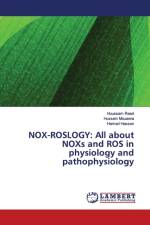- All about NOXs and ROS in physiology and pathophysiology
von Houssam Raad, Hussein Mouawia & Hamad Hassan
88,00 €
The NADPH oxidase (NOX)-mediated release of ROS, also called oxidative burst, leads to the elimination of invading microorganisms in macrophages and neutrophils and thereby serves as an inflammatory mediator. For many years, superoxide generation through NOX was thought to occur only in phagocytes; however, several enzymes responsible for ROS production have been recently identified in various tissues, which differ at the molecular level. These enzymes called NOX/DUOX show similarities to phagocytic NOX (NOX2) and are collectively referred to as the NOX family. NOX/DUOX are now considered the major sources of ROS in cells. Theses enzymes are expressed in several cells and tissues, and their products are essential in many physiological settings. Reactive oxygen species (ROS) are small, oxygen-derived molecules that include oxygen radicals, such as superoxide and and other metabolites. NOX/DUOX are electrogenic, alter ion currents across membranes, induce apoptosis, regulate cytokine production, influence gene expression, and have key roles in signal transduction, immune cell functions, hormone biosynthesis, and other normal biological functions.


